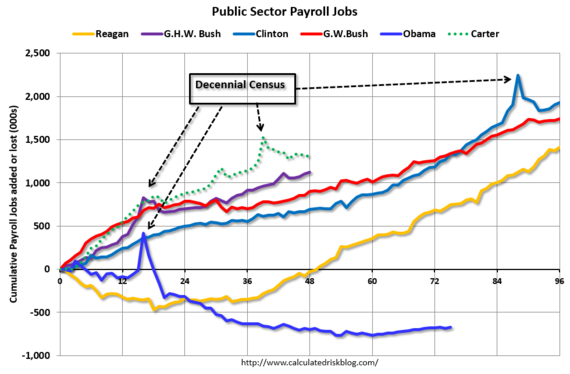The major debate during this campaign season seems to be over the economy. Who has it benefited and who was left behind? Sanders says we aren't spending enough to create more jobs, and Trump wants to build walls to keep any more jobs from leaving US.
But we already know how to create more growth. We have done it before.
President Obama in Elkhart, Indiana touted the strong growth of jobs and incomes since the end of the Great Recession where, for instance, the unemployment rate declined from 19.6 percent to 4.3 percent by the end of 2015.
And 14.5 million jobs have been created under Obama's watch with 9 months left in his term. So he will soon surpass Ronald Reagan's eight-year jobs total and have the second highest job totals behind the 22 million jobs added during President Clinton's term.
The number of long-term unemployed (those jobless for 27 weeks or more) declined by 178,000 to 1.9 million in May. These individuals accounted for 25.1 percent of the unemployed.
But the number of persons employed part time for economic reasons (also referred to as involuntary part-time workers) increased by 468,000 to 6.4 million in May, after showing little movement since November. These individuals, who would have preferred full-time employment, were working part time because their hours had been cut back or because they were unable to find a full-time job.
Both candidates have a point, in that a 2 percent GDP growth rate is at least 1 percent below the historical average, and the labor force participation rate of the working age population is some 4 percent below its highs, even with the current 4.7 percent unemployment rate. Only 63 percent of working-age adults are working, when it has been as high as 67 percent in 2000.
But Europe and Japan are doing even worse. Europe has had 2 recessions and teetered on the edge of a third since 2008. Japan is still trapped in a deflationary economy where prices don't rise at all, and its federal debt level has risen to 200 percent of its GDP. So it has to do more with worldwide economic conditions--such as a lower demand for U.S. good and services from trading partners like Japan, Europe and China.
So who is right? The Great Depression took more than 10 years to recover. It only happened due to the full employment and government spending policies of WWII. In fact, it was prolonged because President Roosevelt listened to a Republican-dominated Congress in 1937 and prematurely raised taxes in an attempt to balance the budget. That's when the economy shrank back into a second recession and it became the Great Depression.
Part of the answer is Bernie's. Government should be creating far more jobs than it has. We have more than $2 trillion in the deferred maintenance of highways, bridges and other public infrastructure says the American Society of Civil Engineers. These are jobs done at both the federal and state levels.
There was a surge in such jobs due to the $830 billion in ARRA funds enacted in 2009 that saved some 3 million jobs--but temporarily, in turned out. Once the no-compromise Republicans took over Congress, there was a government shutdown, then downgrade of U.S. sovereign debt from AAA, and the sequester that literally cut government spending, including for defense.
Here is a comparison in government jobs held since the Carter administration. And Republicans then weren't afraid to create government jobs. The public sector grew during Mr. Carter's term (up 1,304,000), says Calculated Risk, during Mr. Reagan's terms (up 1,414,000), during Mr. G.H.W. Bush's term (up 1,127,000), during Mr. Clinton's terms (up 1,934,000), and during Mr. G.W. Bush's terms (up 1,744,000 jobs).
However the public sector has declined significantly since Mr. Obama took office (blue line in graph--down 638,000 jobs in 2015). These job losses have mostly been at the state and local level, but more recently at the Federal level. This has been a significant drag on overall employment, needless to say.
We are still in recovery from the Great Recession for a number of similar reasons. Not enough money is circulating in the economy, for starters, due to the 8 million lost jobs due to the Great Recession and median household incomes just now returning to pre-recession 2007 levels.
And that is why the lack of government spending to fill the void in private-sector parsimony has been the central reason this recovery has been so slow. The private sector has decided to park their record profits and cash reserves ($4.5 trillion at last count) elsewhere--either overseas, or in Wall Street speculation, or buying back their own stock to increase the record payouts to their CEOs and stockholders.
So we have no New Deal work programs today that created those millions of government jobs during the worst parts of the Great Depression. There is nothing today to compare to those that were employed to create the America we know today--that built not only our dams, roads and major infrastructure, but the writers and artists employed to create the American culture we know today.
We don't need another world war to bring us back to full employment, in other words.
Harlan Green © 2016

